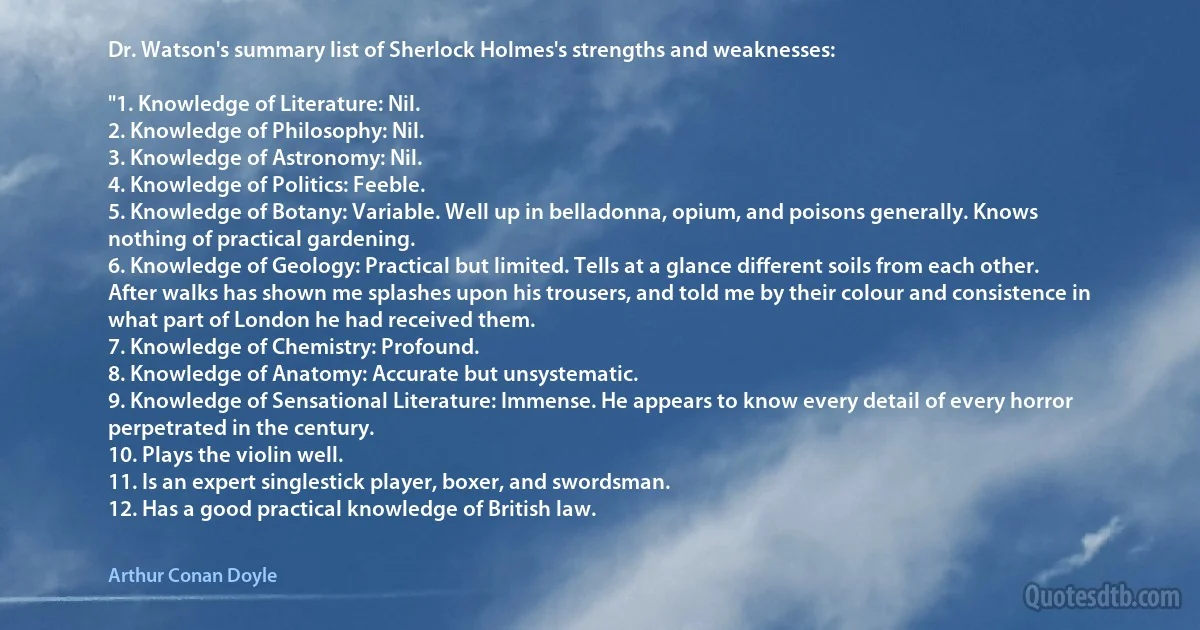
Dr. Watson's summary list of Sherlock Holmes's strengths and weaknesses: "1. Knowledge of Literature: Nil. 2. Knowledge of Philosophy: Nil. 3. Knowledge of Astronomy: Nil. 4. Knowledge of Politics: Feeble. 5. Knowledge of Botany: Variable. Well up in belladonna, opium, and poisons generally. Knows nothing of practical gardening. 6. Knowledge of Geology: Practical but limited. Tells at a glance different soils from each other. After walks has shown me splashes upon his trousers, and told me by their colour and consistence in what part of London he had received them. 7. Knowledge of Chemistry: Profound. 8. Knowledge of Anatomy: Accurate but unsystematic. 9. Knowledge of Sensational Literature: Immense. He appears to know every detail of every horror perpetrated in the century. 10. Plays the violin well. 11. Is an expert singlestick player, boxer, and swordsman. 12. Has a good practical knowledge of British law.
Arthur Conan DoyleRelated topics
anatomy astronomy botany century chemistry different gardening geology good horror knowledge law limited nothing politics show tell trousers variable well sherlockRelated quotes
Like all great churches, that are not mere store-houses of theology, Chartres expressed, besides whatever else it meant, an emotion, the deepest man ever felt,- the struggle of his own littleness to grasp the infinite. You may, if you like, figure in it a mathematic formula of infinity,- the broken arch, our finite idea of space; the spire, pointing, with its converging lines, to Unity beyond space; the sleepless, restless thrust of the vaults, telling the unsatisfied, incomplete, overstrained effort of man to rival the energy, intelligence and purpose of God. Thomas Aquinas and the schoolmen tried to put it in words, but their church is another chapter. In act, all man's work ends there;- mathematics, physics, chemistry, dynamics, optics, every sort of machinery science may invent,- to this favor come at last, as religion and philosophy did before science was born.

Henry Adams
I hope none who hear me will confound this expression of mine with advocacy of the right of a state to remain in the Union, and to disregard its constitutional obligations by the nullification of the law. Such is not my theory. Nullification and secession, so often confounded, are indeed antagonistic principles. Nullification is a remedy which it is sought to apply within the Union, and against the agent of states. It is only to be justified when the agent has violated his constitutional obligation, and a state, assuming to judge for itself, denies the right of the agent thus to act, and appeals to the other states of the Union for a decision; but when the states themselves, and when the people of the states, have so acted as to convince us that they will not regard our constitutional rights, then, and then for the first time, arises the doctrine of secession in its practical application.

Jefferson Davis
I made, for a London television company a programme called 26 Bathrooms ... which was about the ways in which people behaved in their bathrooms. It was about where people put the soap on one level, or the colour of the bathroom curtains, the acoustics, about whether you sang in the bath, and it was structured very simply on the alphabet. We had a man and a woman who arrived one by bus, one by bike, to come and demonstrate for me, in front of the camera, how a jacuzzi operated. I asked both of them to take their clothes off because obviously you don't get into a bath with your clothes on. They hesitate, but eventually their dressing gowns came off and they got into the bath. They had never met one another before. Six weeks later I got an invitation from these people that I had brought together so peculiarly in this jacuzzi -- they were planning to get married! I understand that now they have three children.

Peter Greenaway
The unremitting division of labour resulted in admirable levels of productivity. The company's success appeared to bear out the principles of efficiency laid down at the turn of the twentieth century by the Italian economist Vilfredo Pareto, who theorized that a society would grow wealthy to the extent that its members forfeited general knowledge in favour of fostering individual ability in narrowly constricted fields. In an ideal Paretan economy, jobs would be ever more finely subdivided to allow for the accumulation of complex skills, which would then be traded among workers. ... But however great the economic advantages of segmenting the elements of an afternoon's work into a range of forty-year-long careers, there was reason to wonder about the unintended side effects of doing so. In particular, one felt tempted to ask ... how meaningful the lives might feel as a result.

Alain de Botton
This Mr. Dewhurst has not understood the Impressionist movement in the very least. All he sees in it is a technical method... He also says that before going to London we knew nothing whatsoever about light; but we have studies that prove the contrary. He omits the influence of Claude Lorrain, Corot, all the 18th-century painters, Chardin most of all. But what he fails to realize is that while Turner and Constable were of service to us, they confirmed our suspicion that those painters had not understood 'The Analysis of Shadows', which in the case of Turner are always a deliberate effect, a plain dark patch. As to the division of tones, Turner confirmed us its value as a method, but not as a means of accuracy or truth to nature. In any case, the 18th century was our tradition. It seems to me that Turner too, had looked at Claude Lorrain. I am even inclined to think there is a picture by Turner, 'Sunset', hung side by side with a Claude.

Camille Pissarro
